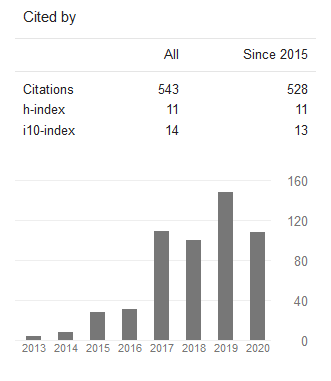Desain Aplikasi Mobile Gamifikasi untuk Pramuka dengan Metode UI/UX
DOI:
https://doi.org/10.24002/jbi.v12i1.4424Abstract
Abstract. The number of Scout members has decreased due to being outdone by other extracurriculars. In addition, given the current pandemic conditions, scouting activities are hampered. This study aims to create an attractive and online Scout mobile application prototype. This research method applies gamification so that scouting activities especially in schools, become more enjoyable and more attractive to students. Apart from gamification, this research also uses UI / UX methods such as usability testing, A / B testing, and User Experience Questionnaires (UEQ). This method is used so that the results of the prototype design can be easily used and understood by the user. The results of this study indicate that the gamification application in this prototype was successful. In addition, the design results that have been tested with the UI / UX method get a mean value of 2.04 and are included in the excellent criteria. Looking at the results of the research, it can be said that gamification makes scouting activities more interesting. Furthermore, the design concept of this application can help scouting activities online.
Keywords: Gamification, Scout, UI/UX.
Abstrak. Jumlah anggota pramuka mengalami penurunan dikarenakan kalah bersaing dengan ekstrakurikuler lainnya. Selain itu, mengingat kondisi pandemi saat ini, kegiatan pramuka menjadi terhambat. Penelitian ini bertujuan untuk membuat purwarupa aplikasi mobile pramuka secara daring dan menarik. Penelitian ini menerapkan gamifikasi agar kegiatan pramuka khususnya di sekolah menjadi lebih menarik minat siswa dan lebih menyenangkan. Selain gamifikasi, penelitian ini juga menggunakan metode UI/UX seperti usability testing, A/B testing dan User Experience Questionaire (UEQ). Metode ini digunakan agar hasil desain purwarupa dapat mudah digunakan dan dimengerti oleh pengguna. Penelitian ini menunjukan penerapan gamifikasi di purwarupa ini berhasil. Selain itu, hasil desain yang telah diuji dengan metode UI/UX mendapatkan nilai rerata 2,04 yang termasuk ke dalam kriteria unggul. Berdasar dari hasil penelitian, dapat dikatakan penggunaan gamifikasi membuat kegiatan pramuka lebih menarik. Selain itu, konsep desain aplikasi ini dapat membantu kegiatan pramuka secara daring.
Kata Kunci: Gamifikasi, pramuka, UI/UX.
References
K. Ramadhani and E. Suharini, “The Effect of Scout Extracurricular to the Integrity of the Students in Elementary School,” J. Prim. Educ., vol. 8, no. 9, pp. 304–310, 2019.
M. G.O., M. F.N, H. E, and M. D. and Sophian R.I, “Disaster Awareness Campaign of Indonesian Boy Scout Gerakan Pramuka for Students,” Proceeding 2nd Join Conf. Utsunomiya Univ. Japan Univ. Padjadjaran, Indones., pp. 42–47, 2017.
H. Megatsari et al., “The community psychosocial burden during the COVID-19 pandemic in Indonesia,” Heliyon, vol. 6, no. 10, p. e05136, 2020.
N. Rulandari, “The Impact of the Covid-19 Pandemic on the World of Education in Indonesia,” Ilomata Int. J. Soc. Sci., vol. 1, no. 4, pp. 242–250, 2020.
D. Johnson, S. Deterding, K. A. Kuhn, A. Staneva, S. Stoyanov, and L. Hides, “Gamification for health and wellbeing: A systematic review of the literature,” Internet Interv., vol. 6, pp. 89–106, 2016.
S. Deterding and R. Khaled, “Gamification: Toward a Definition,” no. March, pp. 1–4, 2014.
A. Omotosho, T. Tyoden, P. Ayegba, and J. Ayoola, “A gamified approach to improving student’s participation in farm practice - A case study of landmark university,” Int. J. Interact. Mob. Technol., vol. 13, no. 5, pp. 94–109, 2019.
M. Sailer, J. U. Hense, S. K. Mayr, and H. Mandl, “How gamification motivates: An experimental study of the effects of specific game design elements on psychological need satisfaction,” Comput. Human Behav., vol. 69, pp. 371–380, 2017.
J. Anggadiredja, Panduan Penyelesaian Syarat Kecakapan Umum Pramuka Golongan Penegak, vol. 53, no. 9. Indonesia, 2011.
L. Aguiar-Castillo, A. Clavijo-Rodriguez, P. De Saa-Perez, and R. Perez-Jimenez, “Gamification as An Approach to Promote Tourist Recycling Behavior,” Sustainability, vol. 11, no. 8, p. 2201, 2019.
R. Garett and S. D. Young, “Health Care Gamification: A Study of Game Mechanics and Elements,” Technol. Knowl. Learn., vol. 24, no. 3, pp. 341–353, 2019.
E. Pesare, T. Roselli, N. Corriero, and V. Rossano, “Game-based learning and Gamification to promote engagement and motivation in medical learning contexts,” Smart Learn. Environ., vol. 3, no. 1, p. 5, 2016.
F. Nah, “Gamification of Education: A Review of Literature - HCI in Business,” Springer, vol. 8527, pp. 401–409, 2014.
I. G. T. Isa and A. Asriyanik, “Game Edukasi Sejarah Gerakan Kemuhammadiyahan dengan Metode Picture and Picture Berbasis Android,” J. Buana Inform., vol. 8, no. 3, pp. 171–180, 2017.
R. E. Randiani and H. B. Dirgantara, “Pembangunan Gim Edukasi Peraturan Lalu Lintas Kawasan Ganjil Genap di Jakarta Berbasis Android,” J. Buana Inform., vol. 11, no. 1, p. 36, 2020.
F. Xu, J. Weber, and D. Buhalis, “Gamification in Tourism,” Inf. Commun. Technol. Tour., pp. 525–537, 2014.
K. A. Utama, E. Nugroho, and N. A. Setiawan, “Analisis Motivasi Hedonis Seseorang Dalam Menggunakan Media Sosial: Studi Kasus Instagram,” J. Buana Inform., vol. 8, no. 2, pp. 99–106, 2017.
F. Xu, D. Buhalis, and J. Weber, “Serious games and the gamification of tourism,” Tour. Manag., vol. 60, pp. 244–256, 2017.
H. Irnawan, S. Yulianti, and S. Hasni, “APLIKASI SYARAT KECAKAPAN UMUM (SKU) PRAMUKA BERBASIS ANDROID DENGAN PENDEKATAN USER EXPERINCE (UX),” J. Teknol. Inf. dan Komun., vol. 6, no. 2, pp. 36–44, 2017.
K. Davis and S. Singh, “Digital badges in afterschool learning: Documenting the perspectives and experiences of students and educators,” Comput. Educ., vol. 88, pp. 72–83, 2015.
S. A. Licorish, H. E. Owen, B. Daniel, and J. L. George, “Students’ perception of Kahoot!’s influence on teaching and learning,” Res. Pract. Technol. Enhanc. Learn., vol. 13, no. 1, p. 9, 2018.
M. Ismail et al., “Determine entrepreneurial characteristics using mobile android gamer freezer,” Int. J. Interact. Mob. Technol., vol. 12, no. 1, pp. 141–150, 2018.
O. Baydas and M. Cicek, “The examination of the gamification process in undergraduate education: a scale development study,” Technol. Pedagog. Educ., vol. 28, no. 3, pp. 269–285, 2019.
L. S. Ferro, S. P. Walz, and S. Greuter, “Gamicards - An alternative method for paper-prototyping the design of gamified systems,” Lect. Notes Comput. Sci. (including Subser. Lect. Notes Artif. Intell. Lect. Notes Bioinformatics), vol. 8770, pp. 11–18, 2014.
Downloads
Published
Issue
Section
License
Copyright of this journal is assigned to Jurnal Buana Informatika as the journal publisher by the knowledge of author, whilst the moral right of the publication belongs to author. Every printed and electronic publications are open access for educational purposes, research, and library. The editorial board is not responsible for copyright violation to the other than them aims mentioned before. The reproduction of any part of this journal (printed or online) will be allowed only with a written permission from Jurnal Buana Informatika.
This work is licensed under a Creative Commons Attribution-ShareAlike 4.0 International License.










